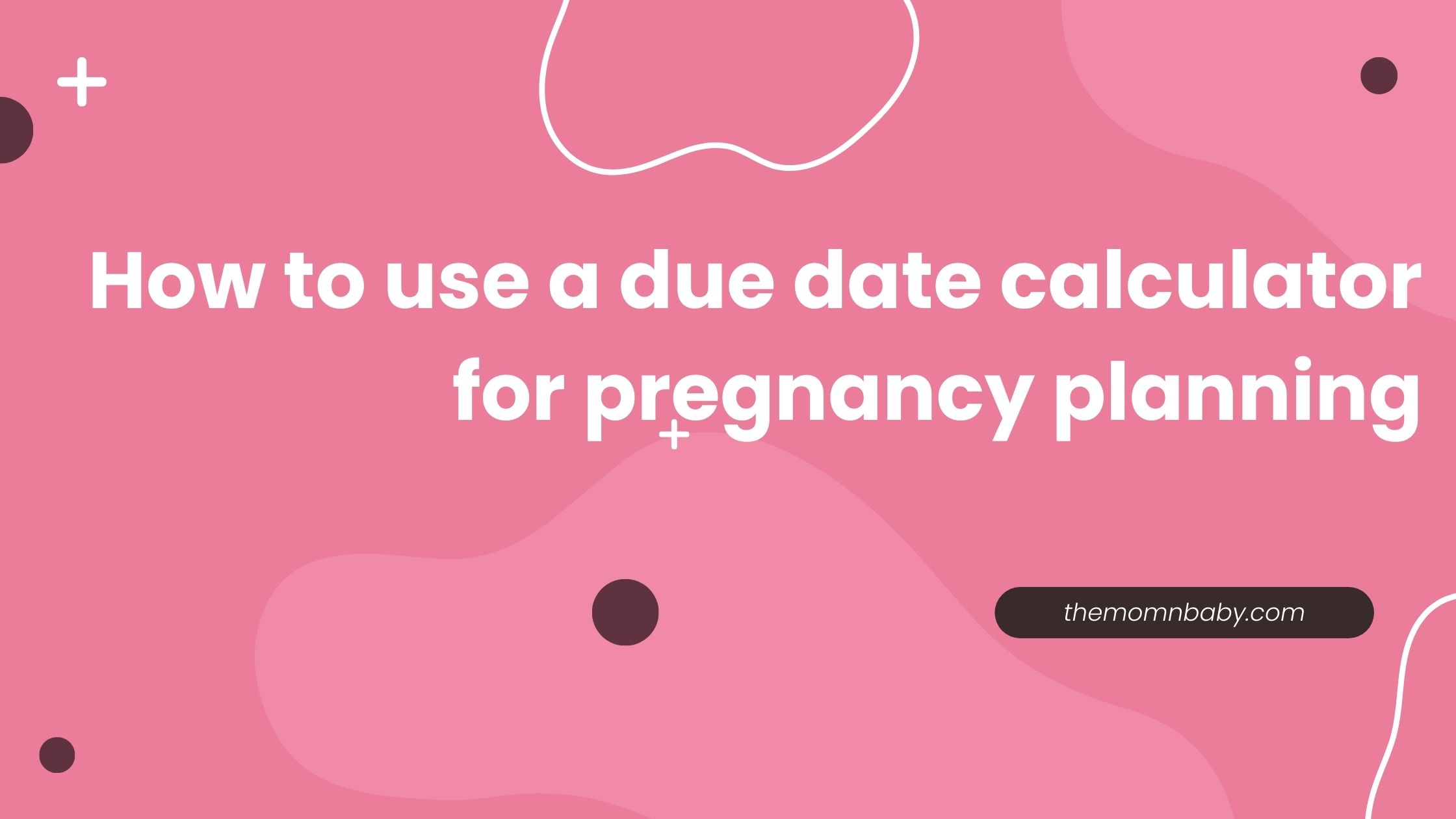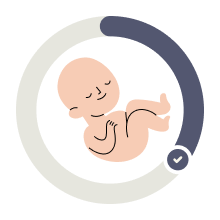As the baby could arrive at any moment, it is advisable to complete your final preparations by the 36th week of pregnancy.
Review your hospital arrival plan and consider all possible scenarios. Keep your boss and coworkers informed about the status of your ongoing projects so they can take over if you are unexpectedly absent from work. Additionally, the 36th week is a perfect time to spend a romantic evening with your partner and enjoy some quality time together.
At the end time of your pregnancy, your baby’s phase of “rapid growth” is nearing completion. It’s crucial to learn about the upcoming developmental changes that your baby will undergo. Additionally, to ensure you’re ready for the big day, have a look at our pre delivery checklist.
Pregnancy Week 36 Quick Facts
- At 36 weeks, you’re nine months pregnant
- You have 4 weeks until your due time “Calculate Your Due Date”
- This is your third trimester
Your Unborn Baby’s Size at 36 Weeks
How Big is a Baby?
At 36 weeks pregnant, your baby weighs approximately 5.8 pounds (2.63 kilograms) and measures about 18.7 inches (47.5 centimeters) from crown to heel, which is roughly the size of a papaya.
Pregnancy Symptoms Week 36
Are you experiencing a feeling of lightness in your belly lately?
This sensation is known as dropping, lightening, or engagement, and it is common around this stage of pregnancy. As your baby prepares for their journey out of the womb, they settle lower into your pelvis. For first-time mothers, this “dropping” usually occurs between two to four weeks before delivery. Additionally, around this time, your milk glands are expanding and filling with colostrum, due to an increase in the hormone oxytocin. As a result, your breasts may feel a bit lumpy.
What is the true time for labor?
If you’ve been wondering how to recognize when it’s truly time for labor, here are some signs to look out for. When you start experiencing regular and strong twinges or cramps that occur every four to five minutes for one to two hours, it’s a good idea to call your doctor. Another indication is a painless leakage of fluid, which signifies that your water has broken, indicating the rupture of the amniotic sac.
Even if contractions haven’t begun immediately after your water breaks, it’s important to deliver your baby within the next 12 to 24 hours to minimize the risk of infection.
Prenatal Tests and Doctor’s Appointments
With your baby’s birthday approaching, your healthcare provider will ensure that you are aware of when to go to the hospital for delivery. Their recommendation will be influenced by the results of your GBS test.
Likelihood of Giving Birth This Week
Roughly 12% of babies are born prematurely, before reaching 37 weeks of gestation. In a comprehensive study analyzing over 34 million births in the United States from 2007 to 2015, approximately 6% of pregnancies resulted in deliveries between 34 and 36 weeks.
Group B Streptococcus (GBS)
Group B streptococcus (GBS) is a type of bacteria that is prevalent but not universally present. It is carried by around 25% of expectant parents (1 in 4). In most healthy adults, GBS does not cause any symptoms and poses no harm. However, it can lead to severe infections or even be fatal for newborns.
Testing Positive
Discovering that you have Group B strep can be alarming, but try not to worry. The treatment is straightforward: you will receive antibiotics during labor. Remember that 25% of pregnant individuals test positive for GBS. While GBS can be dangerous for babies, the likelihood of transmission is rare. If you test positive, your healthcare provider will discuss the plan with you, which will likely involve the following:
- You can continue your daily routine and plans while awaiting the arrival of your baby.
- Once you experience labor contractions or your water breaks, you will likely be advised to proceed directly to the hospital.
- The hospital staff should have your medical records, but you can remind them that you have tested positive for GBS.
- During labor, you will receive intravenous (IV) antibiotics, and if there are no other complications, you can opt for a vaginal delivery.
- Without treatment, approximately 1% to 2% of babies born to GBS-positive mothers develop a GBS infection. However, with treatment during labor, this number significantly decreases to only 1 in 4,000 babies developing an infection.
Special Considerations
You are nearing the final month (4 weeks) before reaching the eagerly awaited 40-week milestone. While babies have a tendency to have their own timing, it is reasonable to assume that you have only a few more weeks of pregnancy remaining, whether you view it as a period to endure or cherish.
While coping with the discomforts that often accompany the late stages of pregnancy, try to savor those precious moments of feeling your baby’s kicks, bumps, and rolls. Many women are taken aback by how much they miss these sensations once their baby has entered the world outside the womb.
Pre Delivery checklist at 36 weeks
Here’s a pre delivery checklist for when you’re 36 weeks pregnant:
- Pack your hospital bag
Make sure to pack important items like your insurance card, toiletries, comfortable clothing, a going-home outfit for your baby, a phone charger, and some snacks for after labor. Your partner may also want to pack their own bag with their personal belongings.
However, it’s best to avoid bringing jewelry, cash, and other valuable items. Additionally, you don’t need to pack diapers, baby clothes, or feeding supplies as the hospital will provide these items.
- Know what to do when labor starts
Consult with your doctor about the signs of labor and when you should call or head to the hospital or birth center. The instructions will depend on your specific circumstances, such as whether you have any complications, whether it’s your first baby, whether you’re planning a cesarean delivery, and how far you live from the hospital.
- Prepare food for after your baby’s birth
Consider doubling your recipes and freezing half if you enjoy cooking. This way, you’ll have nutritious and delicious meals ready to heat up quickly when your newborn arrives.
- Find a pediatrician for your baby
It’s best to find a good pediatrician for your baby before giving birth. You will see your baby’s doctor soon after birth, either in the hospital or after discharge.
Ask about their availability, office hours, insurance acceptance, and their preferred hospital in case your child requires emergency care.
Developmental Milestones
Liver and kidneys
Your baby’s liver and kidneys are functional, and their circulation and immune systems are well-established. As your due date approaches, your baby is also getting closer to being able to breathe independently. Additionally, your 36-week fetus’s skin is becoming smoother and softer, while their gums are becoming more rigid.
Baby’s Position
By the time you reach 36 weeks, there’s a high likelihood that your baby has assumed the head-down position in preparation for their arrival. Approximately 93% of babies have turned downward by this stage, and by 37 weeks, it increases to 97%.
Sleep Cycle
Your baby’s sleep-wake cycle is becoming more established. At 36 weeks, they will continue to display active sleep patterns, but now they also have distinct periods of quiet sleep.
Eyelids
At 36 weeks, your baby’s eyelids have developed smooth edges and are nearly fully formed.
Bones Hardening
The bones of your baby are currently undergoing a hardening process, although they are still softer compared to adult bones. Some bones are initially composed entirely of flexible cartilage, which gradually transforms into bone during childhood. Here’s an interesting fact: Newborns actually have more than 275 bones, whereas adults have 206. This difference is due to certain bones fusing together as they grow and develop.
Survival Outside the Womb
Babies born at 36 weeks are considered “late preterm” or “near term.” While they are very close to being ready for birth, they are still in the process of maturing. Some babies may require minimal assistance after delivery, while others may not need any help at all. Generally, babies at this stage fare well, with a survival rate of over 99%.





